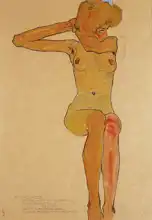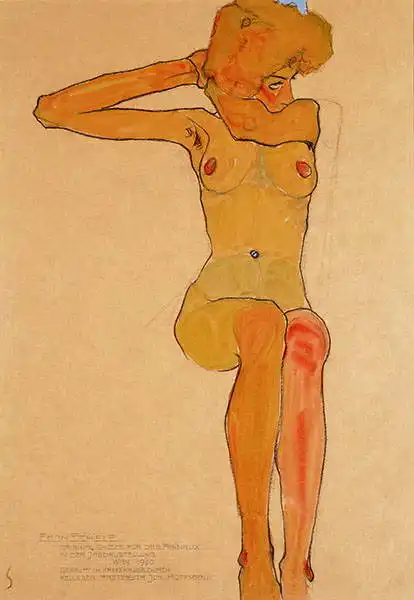About this finishing
Print. The image is printed on the top quality 10-ink HP Z9PS printer on HP matte 270 g / m2 paper. You can choose any size to an accuracy of 1 cm. A margin of 5 cm around the image is added to the size of the motif.


You can find a detailed description about our finishings
here.
Nu assis
"Nu assis" (Sitting Nude) by
Egon Schiele is an
expressive portrait of a female
nude that bears the artist's signature signature. Schiele often focused on the
human figure in his works and provocatively explored intimate and erotic aspects.
The painting "Nu assis" depicts a female figure sitting in a bold and expressive pose. The artist uses elongated shapes and distorted forms, which is typical for his work. It emphasizes not only the physical beauty of the act, but also the emotional expressions and psychological dimension.
The color palette is muted, but at the same time creates an impression of intensity and intimacy. Schiele's lines are sharply defined, thereby emphasizing the contours of the body and creating feelings of expressiveness and passion.
The painting "Nu assis" gives us an insight into the artist's unique view of the human figure and his ability to express the beauty and complexity of the act through an expressive simplification of forms.
Prevailing color of this fine art print is orange and its shape is portrait. This image is printed on demand - you can choose material, size and finishing.
Egon Schiele (1890-1918). Unconventional Viennese artist representing a significant milestone Viennese painting. He quickly broke away from the German movement of new art (Jugendstil) and began to paint in his typical style, with agonizing existential passion for the human body. He painted openly with reference to human sexuality (the images fit into the era when Freud was formulating his theories). Schiele’s paintings are dark, aggressive, and unusual. However, they are thoughtful, excite emotions, and comprise of fascinating drawing and composition. Schiele was tortured by existence, sexuality and the realities of life. His fame grew during his life, although it was very short: after World War I, his wife and child died to typhoid fever and Schiele died after a short time himself.


